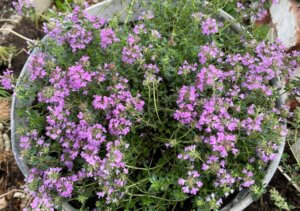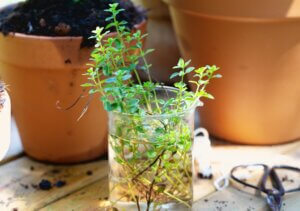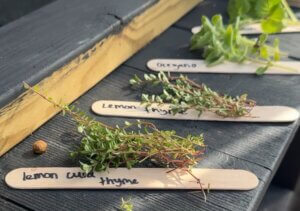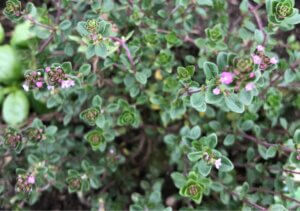
Did You Know? Thyme has strong microbial properties!
The active compound in Thyme, (Thymol) is used in commercial products like Listerine and natural disinfectants, due to it’s effectiveness against bacteria and funghi. The use of Thyme as a microbial can be dated all the way back to Ancient Egypt!
Growing Thyme in the UK
Thyme grows well in the UK, thriving in full sun and well-drained light soil, but can also tolerate drought & poor soil. Common thyme and lemon thyme are popular varieties for cooking, while creeping thyme will work well as ground cover. Best planted in spring from seeds, plugs or cuttings, thyme requires minimal watering and no heavy feeding.
Climate & Hardiness
Thyme grows well throughout most of the UK, particularly in southern and coastal areas — perfect for Devon scenery! A hardy herb that tolerates light frosts and dry conditions once established. In colder regions, thyme may need extra protection, but it will do fine in a sheltered, sunny spot.
Soil Requirements
Thyme prefers well-drained, light soil with a neutral pH. Sandy or loamy soils are ideal, but avoid heavy clay or compacted ground, as it holds too much water which can cause root rot. If drainage is poor, improve it with grit, sand, or organic matter or alternatively grow thyme in containers or raised beds.

Is Thyme easy to grow?
Yes, Thyme is very easy to grow, especially in the UK! It’s one of the most beginner friendly herbs and thrives with minimal care once established!
Propagation
Thyme can be propagated in several easy ways:
- Cuttings: Best done in spring or summer, snip a healthy 7-10cm of a non-flowering stem, strip the lower leaves & plant in moist, well-drained compost. Cover lightly and keep warm & bright.
- Division: Dig up an established plant and gently pull it apart in to clumps of stems, making sure each has roots attached. Replant immediately.
- Seeds: Thyme seeds are slow to germinate, so start indoors in early spring, sow them thinly in trays or pots and keep warm & moist. Only transplant outdoors when all risk of frost has passed.

Planting
The best time to plant thyme outdoors is ideally late spring or early summer, after the last frost of the year. Choose a sunny, sheltered spot with well-drained soil & plant 20-30cm apart. For heavy soil, either improve drainage with added grit or plant in raised beds or pots. Thyme does especially well in terracotta pots or rockeries.
Winter Care
Thyme is generally hardy in most parts of the UK, but may need a bit of care in exceedingly cold or wet winters. Improve drainage if it’s especially wet, mulch lightly with gravel to protect roots or grow thyme in containers to improve maneuverability.
Pruning & Harvesting
Our greenhouse manager, Clayre says: “thyme will eventually need cutting back in Autumn, but will stay in leaf for years!” Make sure you don’t cut in to old woody growth, as this will impede growth.
Start harvesting once the plant is well established, snipping off sprigs as needed – cut just above a leaf node to encourage new growth. Thyme’s flavour is best just before flowering in late spring or early summer

Storage
Depending on how long you’d like your thyme to last, there are a variety of different ways you can store it.
Fresh harvested thyme can be kept in the fridge, wrapped in a damp paper towel & stored in a bag or airtight container which will keep for 7-10 days.
If you’d like to keep your thyme for a little bit longer, you can tie your sprigs in to small bunches and hang upside down in a cool, dry, and well-ventilated area; this process will take 10-14 days, then you can store in an airtight container after stripping the leaves from the stems.
You can also freeze your thyme in ice cube trays with a little water or olive oil, keeping it in perfect condition before adding straight into soups or stews!

Why Grow Thyme? Fragrance, Flavour, and Garden-Friendly Benefits
Thyme is a versatile, low-maintenance herb that rewards you with rich flavour, medicinal benefits, and garden beauty all year round! It thrives in UK climate, drought tolerant & grows happily in pots, borders or even between paving stones. With it’s earthy aroma, thyme enhances countless dishes. Medicinally it’s known for its antibacterial & respiratory-supporting properties. Plus, its tiny flowers attract bees which brightens up any garden space!
Whether you’re a seasoned gardener, or just starting out, thyme is one of the easiest and most rewarding herbs to grow. Start your thyme-growing journey today, and you too can enjoy fresh, home-grown flavour at your fingertips for months to come!

